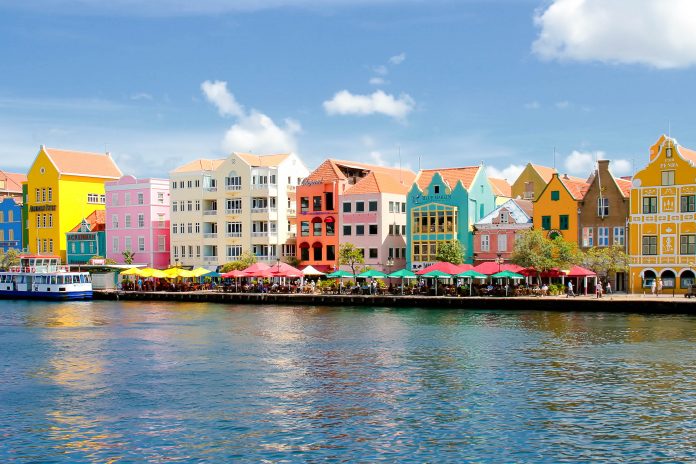Das historische Zentrum von Willemstad, der Hauptstadt der karibischen Insel Curaçao, erinnert durch die niederländische Kolonialherrschaft sehr an Amsterdam – mit dem karibischen Flair eine absolut sehenswerte Mischung!
Willemstad ist die Hauptstadt der karibischen Insel Curaçao, die zu den Niederländischen Antillen gehört. Der Einfluss der Niederländer in Willemstad ist kaum zu übersehen. Die farbenfrohe Hauptstadt mit ihrer quirligen Altstadt gehört zu unseren Top 10 Sehenswürdigkeiten von Curaçao und den Top 10 Sehenswürdigkeiten der Karibik. Seit 1997 zählt das historische Zentrum von Willemstad und sein natürlicher Hafen zum Weltkulturerbe der UNESCO.
Das schmucke Städtchen mit seinen in allen Farben leuchtenden direkt am Wasser errichteten Häusern erinnert sehr an die niederländische Hauptstadt Amsterdam und ist mit ihrem karibischen Flair wahrlich eine Augenweide.
Die Entstehungsgeschichte einiger denkmalgeschützter Häuser lässt sich bis ins 17. Jahrhundert zurückverfolgen. Die meisten dieser luxuriösen, liebevoll restaurierten Wohnhäuser befinden sich in den Stadtvierteln Scharloo und Pietermaai südlich des Schottegat und bieten ein malerisches Zeugnis der farbenprächtigen Architektur aus der Kolonialzeit.
Inhaltsverzeichnis
Fort Amsterdam und Fortkerk
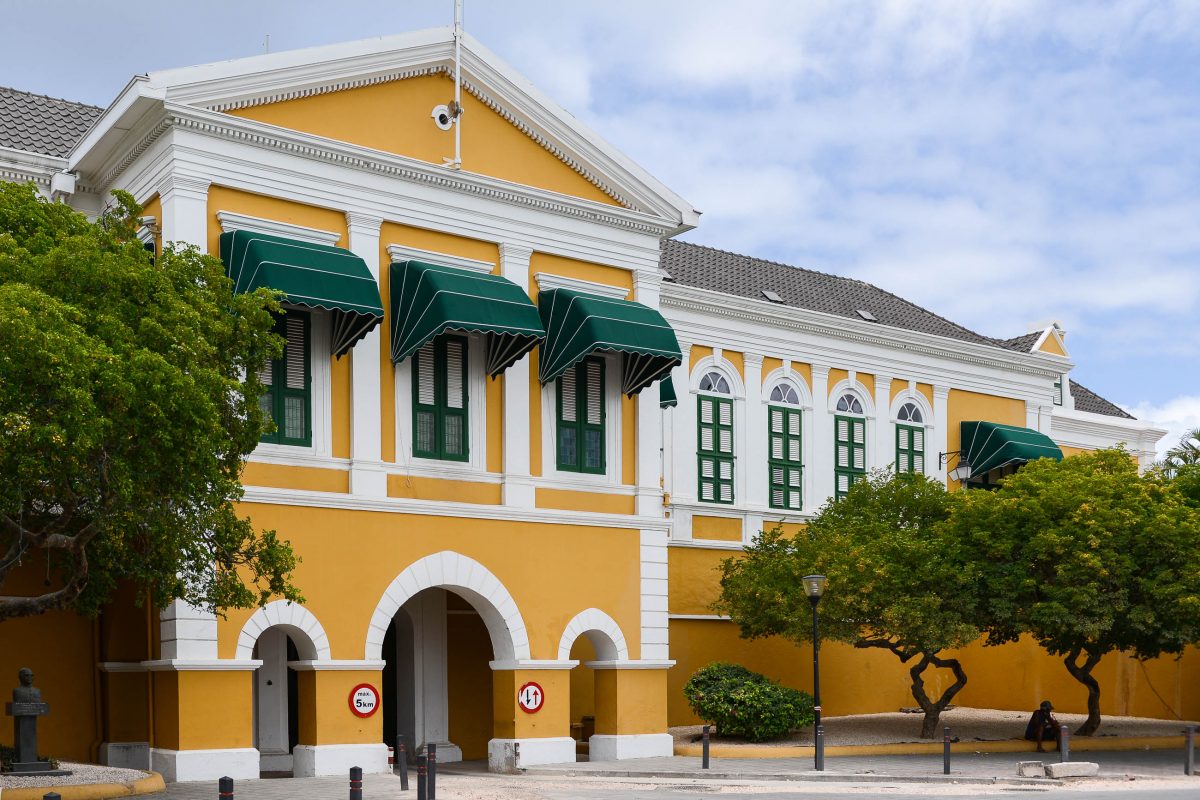
Fort Amsterdam im Stadtviertel Punda ist die wichtigste Festung auf der karibischen Insel Curaçao und die größte Festung der ABC-Inseln. Das Fort Amsterdam ist nicht das einzige auf Curaçao und auch nicht das am besten erhaltene und doch die meistbesuchte Befestigungsanlage der Insel.
Das ab 1634 errichtete und damit älteste Gebäude auf Curaçao bewacht die Hafeneinfahrt zu Willemstad und enthält heute das Parlament, das Ministerium, eine Kirche und ein Museum.
Artikel: Fort Amsterdam in Willemstad
Waterfort
Das Waterfort in Willemstad liegt direkt am Karibischen Meer und an der Sint Annabaai. Es wurde im Jahr 1634 gemeinsam mit dem Fort Amsterdam errichtet und zählt als eines der ältesten Gebäude Curaçaos seit 1997 zum Weltkulturerbe der UNESCO.
Damals bestand Willemstad nur aus dem heutigen Stadtteil Punda, welcher durch das Fort Amsterdam und das Waterfort vor dem Angriff feindlicher Schiffe geschützt war. Das Waterfort ist eigentlich nur ein Befestigungswall, der mit Kanonen und Schießscharten ausgestattet war und erst im Jahr 1748 auf acht Meter Breite erweitert wurde. Damals entstanden auch die Bogengewölbe, die heute noch sichtbar sind, und als Lager für Munition und Proviant diente.
Nach der Eroberung Willemstads durch die Briten, die Curaçao von 1807 bis 1816 besetzten, wurde das Waterfort zu seinen heutigen Ausmaßen ausgebaut, um etwaige folgende Angriffe zu überstehen. 1830 war die geschlossene Mauer fertig, die von der Westecke von Fort Amsterdam bis weit an der Küste entlang reicht.
Im Zweiten Weltkrieg wurde das Waterfort allerdings das letzte Mal militärisch genutzt. Damals diente es als Stützpunkt für die Artilleriegeschütze, die die deutschen Schiffe unter Beschuss nahmen und als Unterkunft für Soldaten.
Heutzutage sind die kriegerischen Tage des Waterforts vorbei und die historische Mauer gehört zum Teil zum markanten Hotelturm des Van der Valk-Plaza. In den Rundbögen sind zahlreiche Boutiquen und Restaurants untergebracht, die unter dem Namen „Waterfort Arches“ direkt an der karibischen Küste Shopping und Schmausen bieten. Vom Hauptplatz Wilhelminaplein aus begrüßen sie Besucher mit „Bon Bini“ („Willkommen!“).
Wilhemina-Plein
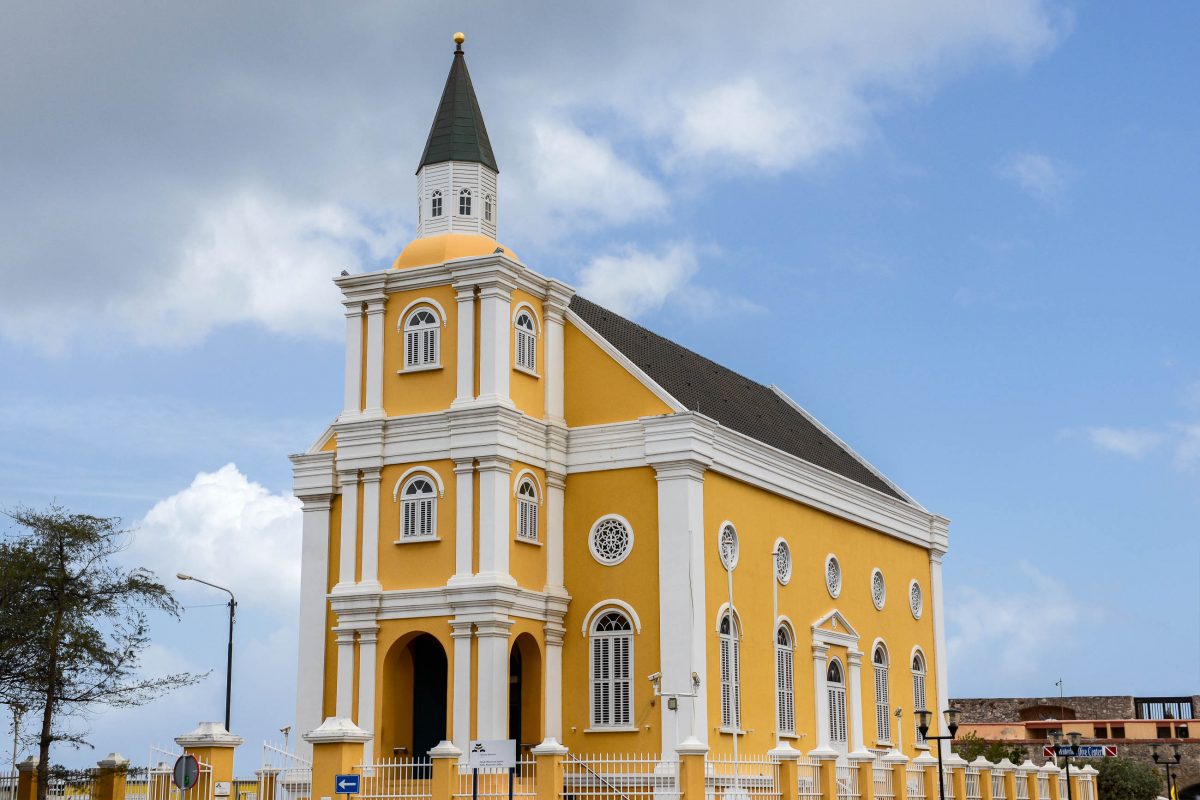
Am Waterfort entlang gelangt man nach wenigen Metern auf den Wilhelmina-Plein, ein parkähnlich begrünter Platz mit dem Stadhuis, dem Rathaus von Willemstad. In diesem klassizistischen Gebäude aus dem Jahr 1859 mit den opulenten Freitreppen und dem goldenen Wappen des Hauses Oranien tagt das Parlament von Curaçao.
Den Abschluss des Wilhelmina-Pleins bildet eine schmucke gelbe Kirche. Die so genannte „Emanu-El“ ist der Sitz einer Reformgruppe sephardischer Juden, die sich im Jahr 1864 von der Mikvé-Gemeinde („Gemeinde der Hoffnung“) abgespalten hat.
Stadtviertel Punda

Rund um das Fort Amsterdam entstand ab 1634 das Stadtviertel Punda („Punkt“). Hier begannen die Holländer nach der Eroberung Curaçaos von den Spaniern mit der Errichtung ihrer Stadt. Der Grund für die Farbenpracht war übrigens die Augenkrankheit eines Gouverneurs der West Indies Company im Jahr 1817, den das grelle Weiß der Fassaden in den Augen schmerzte.
Punda ist jedoch nicht nur der historischste Teil von Willemstad, sondern mit Märkten und Boutiquen auch die beste Shopping-Adresse. Waren aus aller Welt können hier erstanden werden. Zu den bekanntesten Geschäftslokalen zählt die Parfümerie Penha, die in einem der schönsten Gebäude von Willemstad untergebracht ist.
Artikel: Stadtviertel Punda in Willemstad
Synagoge Mikvé Israel-Emanuel
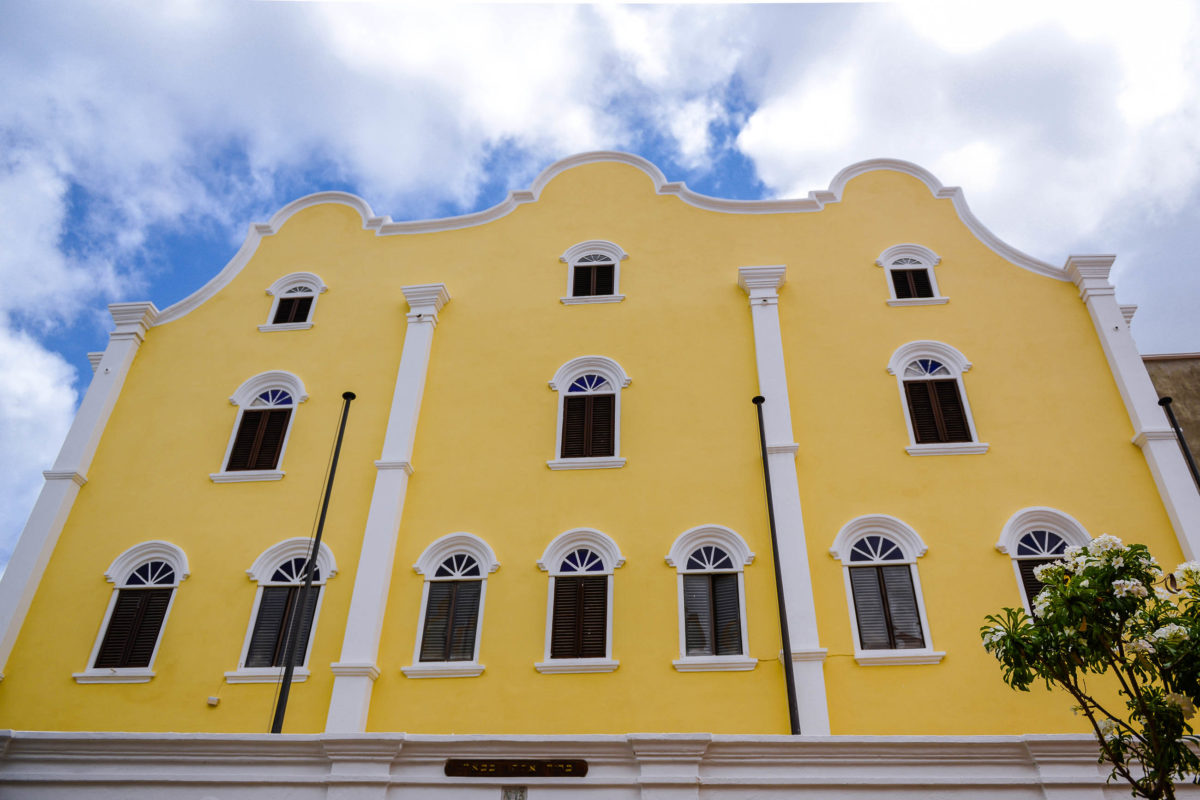
Neben dem ältesten Gebäude von Curaçao ist in Punda auch die älteste Synagoge der gesamten westlichen Hemisphäre zu finden. Die „Mutter aller jüdischen Gemeinden in der Neuen Welt“ kann mit langer Tradition und einem wunderschönen Innenraum aufwarten.
Gegen eine kleine Gebühr kann die Synagoge betreten werden, in der vor allem der sandige Fußboden auffällt. Gegenüber informiert das Museum der jüdischen Gemeinde über Geschichte, Lebensweise und Bräuche der Juden auf Curaçao.
Artikel: Synagoge Mikvé Israel-Emanuel in Willemstad
Schottegat
Die Sint-Annabaai ist jener Kanal, der Willemstad in die beiden Stadtteile Punda und Otrabanda teilt. Der knapp 2 Kilometer lange und etwa 300 Meter breite Kanal, der von zwei interessanten Brücken überspannt wird, mündet auf der einen Seite ins karibische Meer und auf der anderen Seite in den Schottegat.
Dieser war der Grund, aus dem sich die Niederländer im 17. Jahrhundert dort ansiedelten, wo später Willemstad entstand. Der gewaltige Schottegat ist angeblich der siebtgrößte Naturhafen der Welt und heute noch das wirtschaftliche Zentrum der Insel.
Rund um den Schottegat, vor allem in den östlichen Außenbezirken von Willemstad zeugen heute noch einige historische Landhäuser von der Bedeutung, die der Naturhafen damals innehatte.
Tipp: Den besten Überblick über den atemberaubenden Schottegat hat man von der Aussichtsterrasse des Forts Nassau.
Queen-Juliana-Bridge
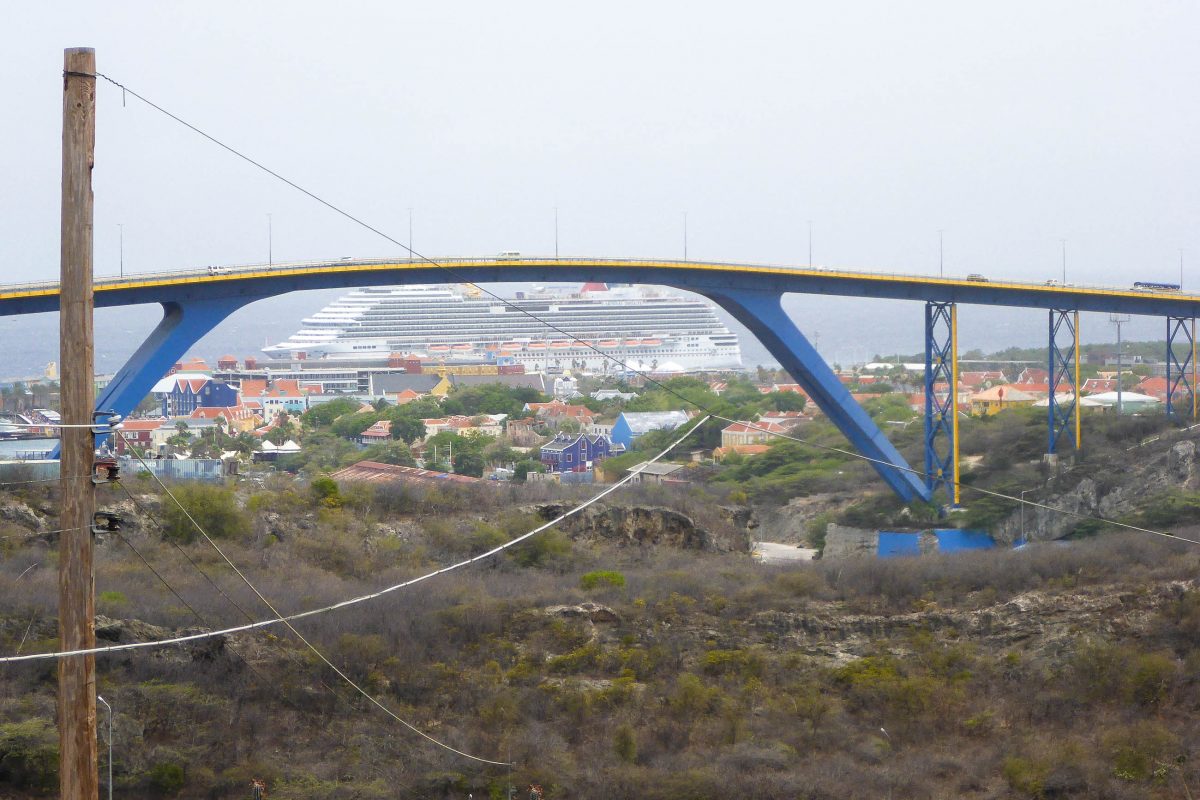
Vor dem Schottegat spannt sich die eindrucksvolle Queen-Juliana-Brücke über die Sint-Annabaai. Sie wurde nach dem Einsturz der ursprünglichen Brücke im Jahr 1967 erbaut und am 30. April 1974, dem Geburtstag der niederländischen Königin Juliana, eröffnet.
Die 56 Meter hohe Autobrücke ist die höchste Brücke in der Karibik und zählt zu den höchsten der Welt. Fährt man über eine der vier Spuren auf der Queen-Juliana-Brücke, tut sich einem ein fantastischer Ausblick über Willemstad mit den beiden Stadtteilen Punda und Otrabanda auf. Durch ihre gewaltige Höhe können auch riesige Tanker und Kreuzfahrschiffe unter der 3.400 Tonnen schweren Brücke hindurch fahren.
Queen-Emma-Bridge
Die letzte Brücke über die Sint-Annabaai vor dem Karibischen Meer ist die Queen-Emma-Bridge. Die 140m lange „Swinging Old Lady“ wird auch als eines der Wahrzeichen von Willemstad bezeichnet. Sie wurde am 8. Mai 1888 eröffnet und im Lauf der Jahrhunderte immer wieder modernisiert. Seit 1974 ist sie ausschließlich Fußgängern vorbehalten, eine Ausnahme wird lediglich am Karnevalssonntag gemacht, wenn die Grand Carnival Parade von Punda nach Otrabanda zieht. Bis heute sichert die über hundert Jahr alte „schwimmende Brücke“ die historische Atmosphäre von Willemstad.
Die Besonderheit dieser so genannten Ponton-Brücke ist, dass sie auf Schwimmkörpern auf dem Wasser liegt und, sobald ein Schiff zum Schottegat durchfahren möchte, per Dieselmotor zur Seite gefahren wird. Die Fahrt der Brücke einmal mitzuerleben ist ziemlich wahrscheinlich, denn der Schwenk wird im Durchschnitt alle ein bis zwei Stunden vollzogen. Kurz zuvor ertönt ein Signalton, der das „Einziehen“ der Brücke ankündigt und die Brücke darf nicht mehr betreten werden.
Wer noch auf der Brücke weilt, muss sich beeilen, ans andere Ufer zu kommen, denn ist die Brücke einmal „abgefahren“, kann sie auch nicht mehr verlassen werden. Bis zu 45 Minuten kann es dauern, bis die Brücke wieder geöffnet wird. Ist die Brücke eingezogen, steht für die Überquerung der Bucht eine kostenlose Fähre zur Verfügung, die alle 15 Minuten ablegt.
Zwei starke Dieselmotoren schwenken schließlich die auf Schwimmkörpern ruhende Brücke um 90°, sodass sie in völlig geöffnetem Zustand parallel zur Sint Annabaai am Ufer des Stadtteils Otrabanda ruht, und anschließend wieder zurück.
Durch diese Konstruktion können riesige Ozeandampfer, Kreuzfahrtschiffe und Frachter direkt an den malerischen Häusern von Willemstad vorbeifahren – ein Spektakel, das wohl sonst nirgends auf der Welt beobachtet werden kann.
Stadtviertel Otrabanda

Über die hübsche Queen-Emma-Bridge gelangt man über die Sint Annabaai von Punda in das Stadtviertel Otrabanda („die andere Seite“), welches 1707 auf der anderen Seite der Sint Annabaai erbaut, nachdem Punda allmählich zu klein wurde. Das Viertel ist mit seinen verwinkelten Gässchen, alten Denkmälern und versteckten Plätzen am besten zu Fuß zu erkunden.
Otrabanda war früher ein wichtiger Sklavenmarkt der Karibik und ist heute immer noch das Zentrum des farbigen Mittelstandes in Curacao, nachdem sich hier im 18. und 19. Jahrhundert viele freigelassene Sklaven ansiedelten. Nach Einbruch der Dunkelheit sollten die engen Gassen von Otrabanda von Touristen eher gemieden werden.
Artikel: Stadtteil Otrabanda in Willemstad
Festung Riffort
Auch Otrabanda erhielt eine Festung zu seinem Schutz: Das Riffort, liegt genau gegenüber von Fort Amsterdam. Neben dem Fort Nassau auf dem Hügel über dem Schottegat und dem Fort Waakzamheid ist das Riffort die dritte Festung in Willemstad, in der man innerhalb von historischen Mauern speisen kann.
Die Festung wurde in den Jahren 1824 bis 1828 errichtet und kann durch ein imposantes Eingangstor betreten werden. Eine schmale Treppe führt auf die Dachterrasse, die einen traumhaften Rundblick über das offene Meer und den Stadtteil Punda mit dem eindrucksvollen Fort Amsterdam und den Mauern des Waterfort bietet.
Gleich dahinter betritt man einen langgestreckten Innenhof, der von ehemaligen Magazinen in Rundbögen umrahmt wird, die heute privat genutzt werden. Der kleine Gastgarten und der rustikal-gemütlichen Innenraum eines französischen Lokals laden zum Platznehmen ein. Die vorzügliche Speisekarte beinhaltet neben karibischen Spezialitäten auch Käsefondue und Mousse au Chocolate nach Französisch-Schweizer Geschmack.

